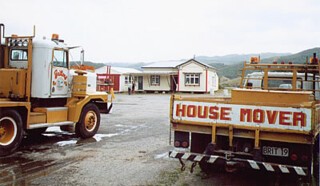Iam in Wellington, where I spent my first twenty years. I have walked, as I used to then, down the hill from Wadestown. The pines are now taller and blacker and the glossy mounded foliage of native shrubs covers the banks of cuttings more densely. In those days, after heavy rain, there were landslips. It has been very wet this year but only one yellow patch shows where a few tons of rotten rock and clay slid down to spill over the road.
Houses speckle the steep green hills around the harbour more thickly than they did in the past, because pieces of land so close to vertical that you would not trust yourself to scramble down them are now built on, as are plots perched on the fault scarp itself. Houses are tucked in or cantilevered out, the carports and backs of houses are supported on stilts, and verandahs and decks project over long drops, down to roofs or bush below. Zigzag paths and steep steps cut up and down the hillsides.
The majority of these houses are timber-framed. Walls do not rise, course by course, as those of brick or stone would do. Instead studs and plates (upright and horizontal lengths) and short spacing pieces (dwangs) define interior and exterior walls and offer a complete X-ray of the structure – like a model made of matchsticks – before the cladding of boards or sheet material dresses it in a not always expected style.
Timber frame-houses are light: you can move them about – people quite often do. In a lot to the north of the city you can see dozens of bungalows – even a few two-storey houses – lined up like second-hand cars. The price (NZ$30,000) includes delivery and placing on piles, and you can walk through the houses, working out just how you might bring together the two halves of a big one which has been sliced through to help the trailer get it round corners. Because only the piles – the posts they stand on – are in contact with the ground, rising damp is not a problem. In some ways these buildings are more like boats than houses of brick or stone. A skin of planks and plasterboard stiffens the skeleton of studs and plates. Corrugated iron holds the roof trusses in place.
If you grow up among houses which are lightly tied to the ground moving them seems almost as natural as shuffling furniture around inside. In Wellington a planning application to move a substantial concrete ambulance station a couple of hundred metres went to court. You can understand that conservation groups might want to keep a few landmarks in place. Over the hill from Wellington is Martinborough – a town with a street plan based on the Union Jack. Its present prosperity is based on wine and weekend retreats. A local man who wanted to ship in a house was asked to sound out the neighbours: there were no objections, but one woman did a double-take when she realised that she would be looking out at the house which had been opposite hers when she was growing up in a town miles away. In Auckland there are meetings between contractors to see that none of the dancers in the slow night-waltz of buildings bumps into any of the others.
Timber frame-houses don’t so much blow down as blow over. Christopher Cochran, a conservation architect, showed me a picture of the church of St John Rangitukia which did blow over. The locals pulled it back to its feet. Now wooden props like flying buttresses prepare it for the next storm.
Just as England’s Navy outgrew the country’s ability to supply oak, so in New Zealand building and exports reduced the forests of huge kauri trees (up to 120 feet high and 15 feet in diameter) from a resource to a preserved remnant. In 1850 Kauri timber was, briefly, the country’s main export: the Royal Navy prized the long, knot-free trunks as material for masts and spars. Any 19th-century house is likely to be built from it: indeed, some of the battered houses waiting in the parking lot could be sources of recycled timber. The big Victorian government building in the middle of Wellington (it now houses the university law faculty) has kauri planks over an Australian hardwood frame. It has the style of a stone or stucco building and its architect must have hoped it would be rebuilt in some more permanent material. Like any number of other buildings, it shows that wood, when it is hoisted above the damp earth, lasts very well.
The outer skin of a frame-house has two layers: weather boards or sheet material on the outside and plasterboard or something like it on the inside. In between it is possible to put insulation. These days it will be something like glass wool, but outside Martinborough Cochran showed me an old frame building where a few boards had fallen away to reveal that the wall cavity was stuffed with fleeces.
Construction methods have on the whole changed less radically than styles, however. Despite bigger windows and more decks and odder profiles and plans the new houses will still shudder and tremble a little in a high wind, rain will still rattle on tin roofs (although you may hear it less now insulation is better) and Wellington houses will still be scattered, broadcast like seed over the mounded hills.
The high-rise buildings in the middle of town squat heavily, hinting at the muscle which will hold them together when an earthquake strikes. The frame-houses, on the other hand, seem to have alighted like passing birds on unlikely perches. There is a real chance that some will slide when the earthquake comes. When that will be no one knows; there are mixed feelings about the likely effect on real estate values of the local authority’s plan to give an earthquake-risk rating to all properties.
Painters have not made much of Wellington houses, but in Rita Angus’s picture of Thorndon, the part of the city she lived in, the verandah-fringed houses and cottages, clustering under the pine-covered cliff of the fault scarp, give some idea of the logic behind the random scramble of building – a geometry in which buildings look for light and a view of the hills or the sea in much the same way that a field of sunflowers turns to the sun.
Send Letters To:
The Editor
London Review of Books,
28 Little Russell Street
London, WC1A 2HN
letters@lrb.co.uk
Please include name, address, and a telephone number.



